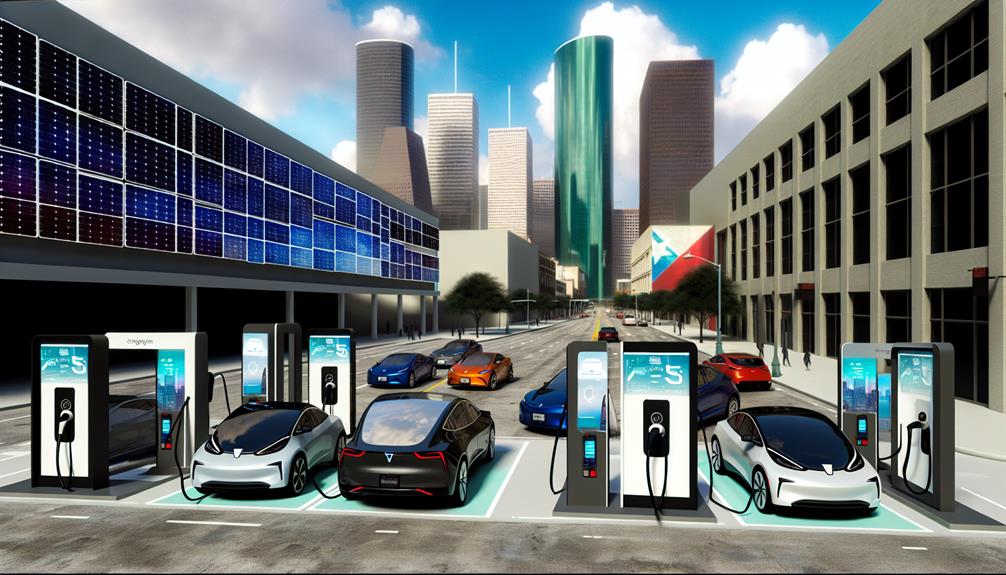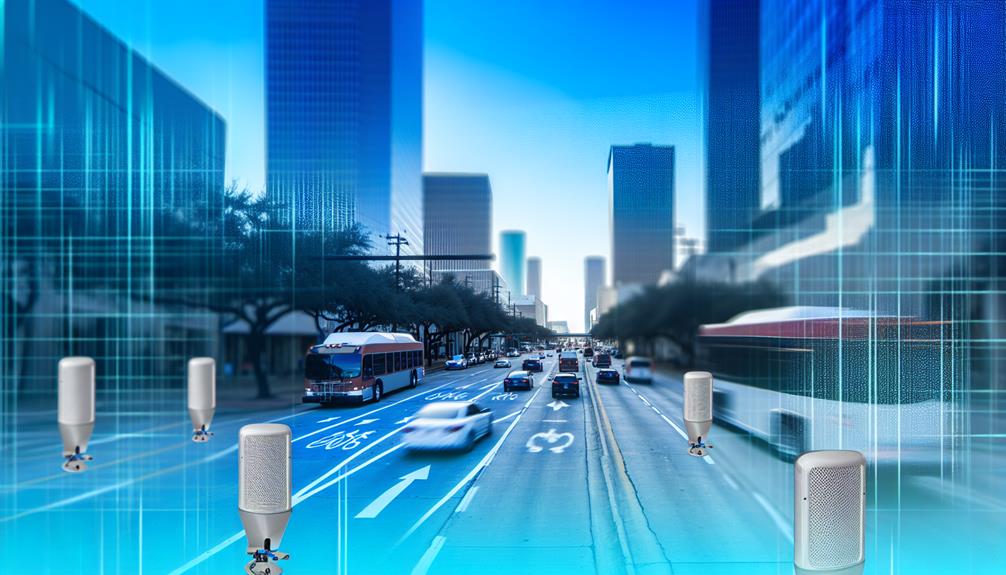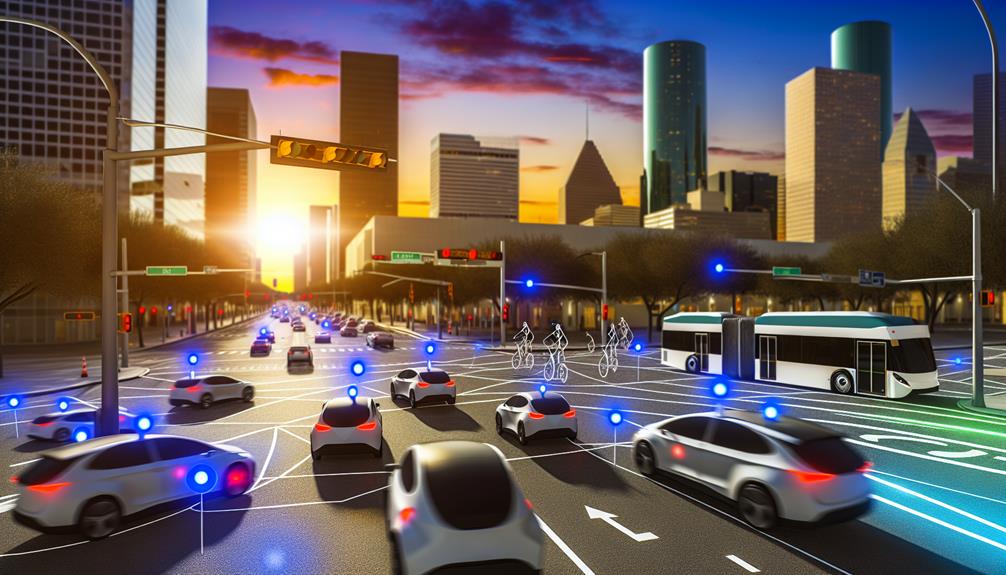Improving Houston's transportation scene with technology might seem like a daunting task, but trust me, it's totally doable. By bringing in smart traffic systems and using real-time data to plan routes better, we can totally revamp how we get around the city.
Picture this: electric vehicle charging stations popping up, handy mobile apps for public transit, and sensors keeping tabs on air quality. These innovations are shaping the future of transportation in Houston, making our urban environment more sustainable and efficient.
Stay tuned as we dive into how these changes are making a real difference on the ground.
Smart Traffic Management Systems
Introducing smart traffic management systems has truly transformed the way we navigate city streets, especially here in Houston. These systems work wonders by analyzing real-time traffic data and tweaking signals on the fly to ease congestion and boost overall efficiency. Imagine smoother commutes, shorter travel times, and even less fuel burn – that's the magic these systems bring to our daily drives.
In Houston, smart traffic management systems are like traffic wizards; they keep emergency vehicles, public transport, and pedestrians moving smoothly and safely. By giving them top priority, these systems enhance road safety and accessibility for everyone. Not only do they make our daily commutes a breeze, but they also play a vital role in building a greener, more connected transportation network for our city.
Real-Time Data for Route Optimization
Have you ever been stuck in traffic, wishing there was a way to avoid the gridlock and get to your destination faster? Well, real-time data integration is changing the game when it comes to route optimization. Picture this: live traffic updates coming in, showing you alternative paths to beat the jams and make your journey more efficient. It's all thanks to GPS technology and traffic monitoring systems working together to help transportation services plan better routes and cut down on travel time. By making dynamic adjustments based on real-time data, you can steer clear of congested areas, reducing emissions and keeping traffic flowing smoothly.
Having access to real-time data means transportation services can quickly adapt to changing road conditions, making everything run more smoothly for commuters. Not only does integrating real-time data into transportation systems improve routes, but it also ensures a greener, more sustainable approach to getting around in cities.
With real-time data on hand, you can make smart decisions to optimize your route in the moment, dodging traffic bottlenecks and delays. This data-driven approach doesn't just make transportation more efficient and reliable—it also benefits the environment. So, next time you're on the road, remember the power of real-time data in making your journey better for you and the planet.
Electric Vehicle Charging Infrastructure

Integrating electric vehicle charging infrastructure in Houston plays a crucial role in advancing the city's sustainable transportation goals and cutting down on carbon emissions. Houston's current focus on researching electric bus charging infrastructure aligns with its efforts to transition to electric or hydrogen-powered buses. Through strategic placement of charging stations, Houston aims to smoothly incorporate electric vehicles into its transportation system, promoting sustainability and reducing greenhouse gas emissions.
The city's expansion plans for charging infrastructure also support its ambitious target of converting the municipal car fleet to all electric vehicles by 2030. Reliable and easily accessible charging stations are key to encouraging wider adoption of electric vehicles in Houston, ultimately contributing to a greener and more environmentally-friendly transportation sector. As the city continues to embrace electric vehicle technology, the development of robust charging infrastructure will be essential for driving progress towards a more sustainable and eco-conscious transportation network.
Mobile Apps for Public Transit Info
In Houston, making your commute more sustainable and convenient is a breeze with apps like METRO's RideMETRO and Houston BCycle. These handy tools provide real-time updates on public transportation, allowing you to plan your trips, check arrival times, and see bike availability on the go. By keeping track of buses, trains, and bikes in real-time, these apps make using public transportation a cinch, helping reduce the need for personal vehicles.
Having access to up-to-date transit information at your fingertips not only helps you make smarter travel choices but also encourages eco-friendly commuting. With features that empower you to opt for sustainable transportation options, these apps play a key role in cutting down traffic congestion in Houston. They align perfectly with the city's push for tech-driven solutions to enhance the transportation sector.
Sensors for Air Quality and Traffic

Setting up sensors across Houston to monitor air quality and traffic in real-time could truly transform how the city tackles pollution and congestion. These sensors provide valuable data for city leaders and residents alike, empowering them to make informed choices on transportation and environmental policies. By analyzing this data, Houston can craft specific plans to cut emissions and improve air quality in busy areas. This effort meshes with Houston's goal to reach carbon neutrality by 2050, showing a strong dedication to sustainability and cutting-edge transportation solutions. Bringing in sensor technology not only helps create a greener environment but also streamlines transportation for locals.
| Advantages of Air Quality and Traffic Sensors |
|---|
| Instant pollution level updates |
| Data-guided policy decisions |
| Tailored emission reduction plans |
| Support for Houston's carbon neutrality aim |
| Boosted sustainability and transport efficiency |
Frequently Asked Questions
How Does Technology Improve Public Transportation?
Ever wondered how technology is revolutionizing public transportation? Picture this: it's like having a personal guide for buses, cutting down on those frustrating wait times with smart ticketing, navigating through traffic like a pro to avoid jams, and keeping you updated in real-time. Pretty neat, right?
What Can We Do to Improve Transportation?
Improving transportation options is key to making our daily commutes smoother and more sustainable. One way to achieve this is by introducing smart traffic systems that help streamline the flow of vehicles on the road. Additionally, expanding the network of charging stations for electric vehicles can encourage more people to make the switch to eco-friendly transportation.
Enhancing public transit with modern, eco-friendly buses not only reduces emissions but also provides a more comfortable and efficient way to travel. Building bike lanes alongside roads promotes a healthier and more environmentally friendly mode of transportation for cyclists.
Analyzing data to ensure efficient maintenance of transportation infrastructure is crucial for keeping everything running smoothly. By taking these steps, we can create a more sustainable and less congested transportation system for everyone to enjoy.
What Transportation Is Used in Houston Texas?
When it comes to getting around Houston, personal vehicles are the go-to choice, supported by buses, light rail, biking, walking, and rideshares. With highways sprawling across the city, METRO operating buses and trains, bike lanes expanding, and ridesharing services thriving, the transportation scene in Houston, Texas is diverse and evolving. It's easy to navigate the city using these options, each offering its own unique experience and convenience.
How Can I Improve Transportation in My Area?
If you're looking to improve transportation in your area, here are some practical steps you can take. Investing in smart traffic systems can help ease congestion and make your daily commute smoother. Consider opting for low-emission vehicles to reduce pollution and promote a cleaner environment. Expanding public transport options and encouraging ride-sharing can also make a big difference in reducing the number of single-occupancy vehicles on the road. Don't forget to develop cycling infrastructure to encourage more sustainable commuting choices. By taking these steps, you can help create a more efficient and eco-friendly transportation system in your area.
